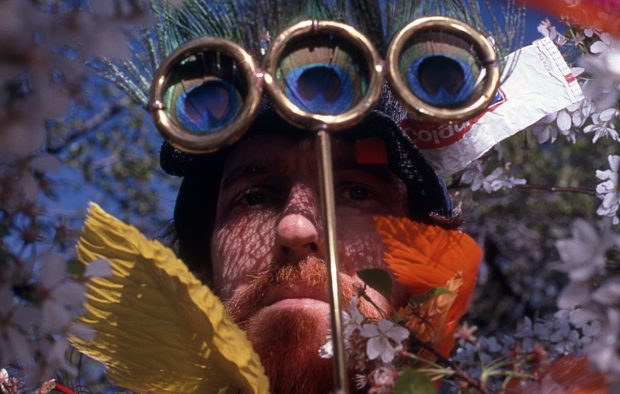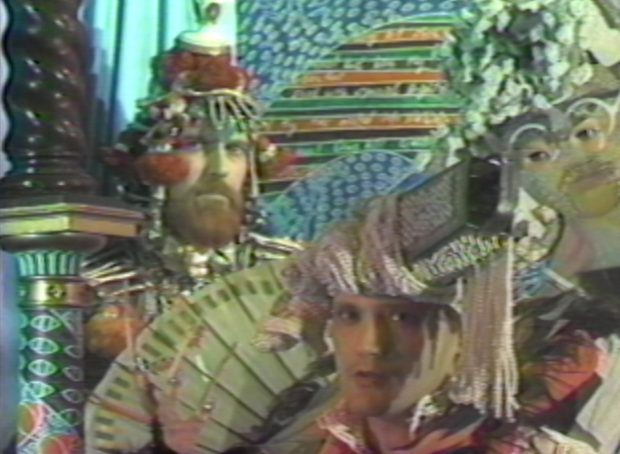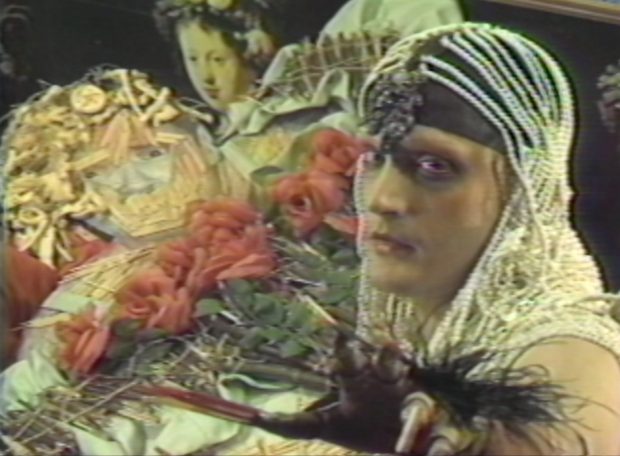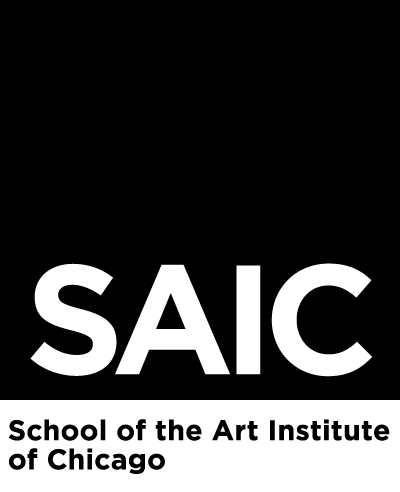On Stephen Varble
Posted by | Nicky Ni | Posted on | October 10, 2018

Daniel Cahill as Sage Purple Pythagoras from Stephen Varble’s Journey to the Sun, ca.1980. Photographer unknown.
In the 1970s, Manhattan-based artist Stephen Varble gained infamy for his gender-confounding costume performances. Art historian and curator David Getsy, who will present excerpts of Varble’s ribald unfinished epic, Journey to the Sun (1978-1983), at the event tomorrow, shares his research on Varble’s artistic practices in relation to the video. This screening coincides with the exhibition, Rubbish and Dreams: The Genderqueer Performance Art of Stephen Varble, that Getsy curates at the Leslie-Lohman Museum of Gay and Lesbian Art, New York. The following excerpt comes from his curatorial text for the exhibition.
Stephen Varble’s last five years were consumed with working on an epic, operatic work of video art: Journey to the Sun. It started in 1978 as a performance about the mythology of Greta Garbo, and Varble invited friends to his Riverside Drive apartment to view his monologues accompanied by projected slides. His ambitions soon outgrew this format, and he turned to video for its ability to combine text, image, and performance. He considered these videos to be revivals of illuminated Medieval manuscripts with their rich visual play between words and pictures, and he called his group of collaborators in the video the “Happy Arts School of Manuscript Illumination.” The aim of the “school” was to promote Varble’s vision of societal transformation through the making of modern fables in the form of videos, books, and prints.
Journey to the Sun tells the story of a musician, the Grey Crowned Warbler, who undergoes tribulation and metamorphosis on a journey to transcendence. The tale is a loosely autobiographical fable of an artist who encounters a stern mystical teacher, Sage Purple Pythagoras (played by his partner, Daniel Cahill) who tests the Warbler. Many of Varble’s iconic costumes feature in the video, and he combined elements of his own history with references to literature, religion, and popular culture (notably, Garbo). Combining heavily scripted monologues with improvised performances, Journey to the Sun does not offer a tidy or easily understood narrative. Rather, it sketches a fantastic and surreal visual world in which dreams are realized through the transformations of everyday objects, popular imagery, and rubbish.
To make this “rodeo-paced” video, Varble filled his apartment with drawings and writings on the walls, blacked out the windows, and began filming scenes both scripted and improvised with collaborators. Journey to the Sun is remarkable for its time due to the complexity and density of the video editing — all of which was done by Varble in the apartment. He liked video tape for its ability to be reproduced cheaply, and he hoped to make multiple “video books” to send into the world. Varble only completed about thirty percent of his planned work before his death from AIDS-related complications in the first days of 1984. This is but a fragment of the much longer video epic Varble hoped would be his major contribution. It is being shown publicly for the first time in relation to the retrospective exhibition Rubbish and Dreams: The Genderqueer Performance Art of Stephen Varble at the Leslie-Lohman Museum of Gay and Lesbian Art, New York, from 29 September 2018 to 27 January 2019.
David Getsy is an art historian, art writer, and curator. His books include Abstract Bodies: Sixties Sculpture in the Expanded Field of Gender (2015) and Queer (2016). His other recent curatorial projects are Jared Buckhiester: Love Me Tender, a 10-year survey of drawings, for the Bureau of General Services—Queer Division in New York (2017) and an exhibition of Stephen Varble’s xerographic prints for Institute 193 in Lexington, Kentucky (2018). Getsy holds a BA from Oberlin College and a PhD from Northwestern University. He has received fellowships and awards from the Graham Foundation for Advanced Studies in the Fine Arts, Queen Mary University of London, the Terra Foundation for American Art, the Clark Art Institute, and the National Gallery of Art’s Center for Advanced Study in the Visual Arts, among others. He teaches at SAIC, where he is the Goldabelle McComb Finn Distinguished Professor of Art History.
For further Reading:
New York Times feature on “Rubbish and Dreams“
David Getsy interviewed by THEM magazine on the Stephen Varble’s retrospective
Essay by David Getsy previewing the exhibition
Tags: David Getsy > Leslie-Lohman Museum of Gay and Lesbian Art > New York > performance art > Stephen Varble > Video Art


